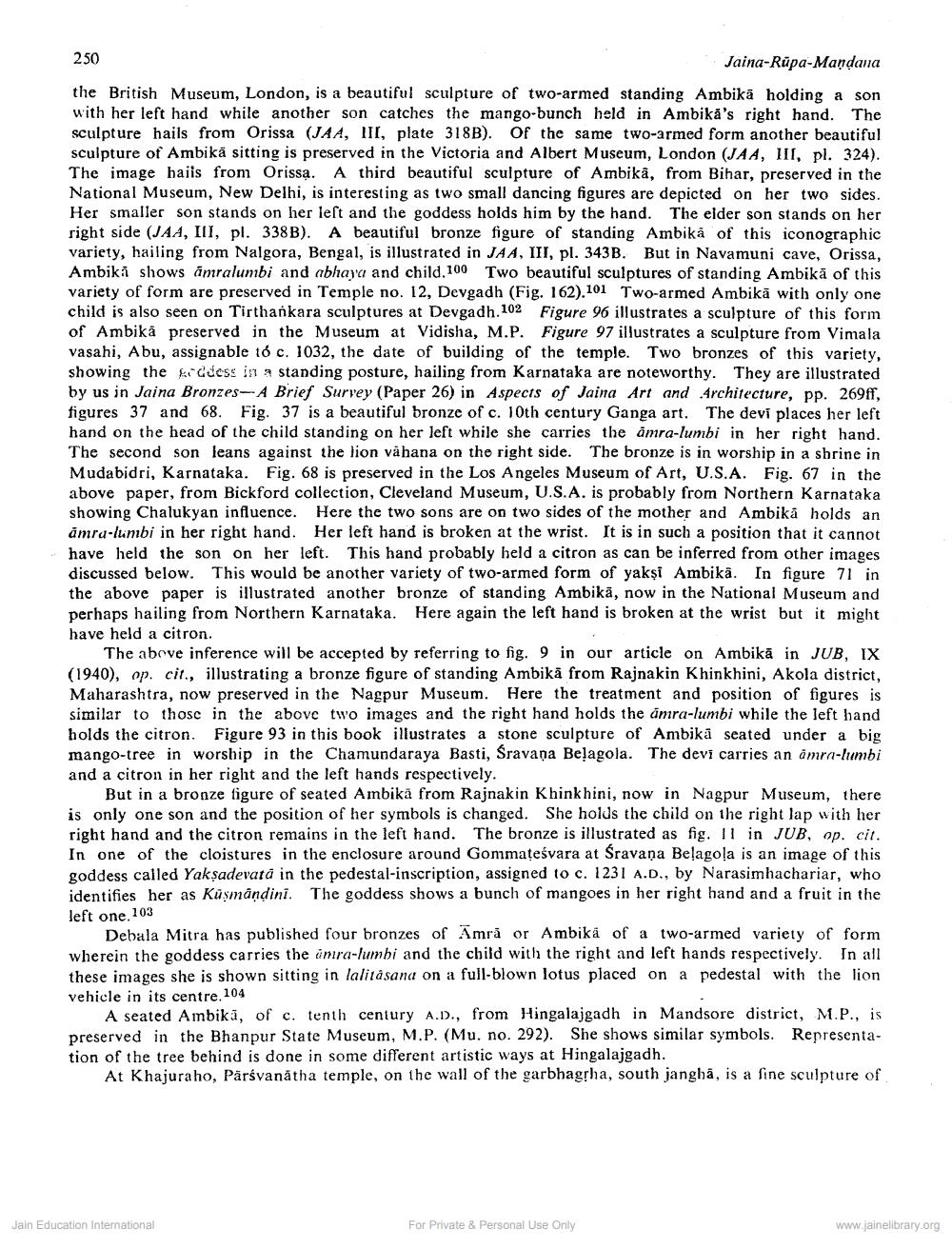________________
250
Jaina-Rupa-Mandana the British Museum, London, is a beautiful sculpture of two-armed standing Ambikä holding a son with her left hand while another son catches the mango-bunch held in Ambika's right hand. The sculpture hails from Orissa (JAA, III, plate 318B). Of the same two-armed form another beautiful sculpture of Ambikä sitting is preserved in the Victoria and Albert Museum, London (JAA, III, pl. 324). The image hails from Orissa. A third beautiful sculpture of Ambika, from Bihar, preserved in the National Museum, New Delhi, is interesting as two small dancing figures are depicted on her two sides. Her smaller son stands on her left and the goddess holds him by the hand. The elder son stands on her right side (JAA, III, pl. 338B). A beautiful bronze figure of standing Ambika of this iconographic variety, hailing from Nalgora, Bengal, is illustrated in JAA, III, pl. 343B. But in Navamuni cave, Orissa, Ambika shows amralumbi and abhaya and child. 100 Two beautiful sculptures of standing Ambikā of this variety of form are preserved in Temple no. 12, Devgadh (Fig. 162).101 Two-armed Ambikā with only one child is also seen on Tirthańkara sculptures at Devgadh.102 Figure 96 illustrates a sculpture of this forin of Ambika preserved in the Museum at Vidisha, M.P. Figure 97 illustrates a sculpture from Vimala vasahi, Abu, assignable to c. 1032, the date of building of the temple. Two bronzes of this variety, showing the addoss in a standing posture, hailing from Karnataka are noteworthy. They are illustrated by us in Jaina Bronzes- A Brief Survey (Paper 26) in Aspects of Jaina Art and Architecture, pp. 269ff, figures 37 and 68. Fig. 37 is a beautiful bronze of c. 10th century Ganga art. The devi places her left hand on the head of the child standing on her left while she carries the amra-lumbi in her right hand. The second son leans against the lion vahana on the right side. The bronze is in worship in a shrine in Mudabidri, Karnataka. Fig. 68 is preserved in the Los Angeles Museum of Art, U.S.A. Fig. 67 in the above paper, from Bickford collection, Cleveland Museum, U.S.A. is probably from Northern Karnataka showing Chalukyan influence. Here the two sons are on two sides of the mother and Ambiká holds an amra-lumbi in her right hand. Her left hand is broken at the wrist. It is in such a position that it cannot have held the son on her left. This hand probably held a citron as can be inferred from other images discussed below. This would be another variety of two-armed form of yakşi Ambika. In figure 71 in the above paper is illustrated another bronze of standing Ambikā, now in the National Museum and perhaps hailing from Northern Karnataka. Here again the left hand is broken at the wrist but it might have held a citron.
The above inference will be accepted by referring to fig. 9 in our article on Ambika in JUB, IX (1940), op. cit., illustrating a bronze figure of standing Ambika from Rajnakin Khinkhini, Akola district, Maharashtra, now preserved in the Nagpur Museum. Here the treatment and position of figures is similar to those in the above two images and the right hand holds the amra-lumbi while the left hand holds the citron. Figure 93 in this book illustrates a stone sculpture of Ambika seated under a big mango-tree in worship in the Chamundaraya Basti, Sravana Belagola. The devi carries an amra-lumbi and a citron in her right and the left hands respectively.
But in a bronze figure of seated Ambika from Rajnakin Khink hini, now in Nagpur Museum, there is only one son and the position of her symbols is changed. She holds the child on the right lap with her right hand and the citron remains in the left hand. The bronze is illustrated as fig. 11 in JUB, op. cit. In one of the cloistures in the enclosure around Gommateśvara at Sravana Belagola is an image of this goddess called Yakşadevata in the pedestal-inscription, assigned to c. 1231 A.D., by Narasimhachariar, who identifies her as Kuşmandini. The goddess shows a bunch of mangoes in her right hand and a fruit in the left one. 103
Debala Mitra has published four bronzes of Amrā or Ambika of a two-armed variety of form wherein the goddess carries the imra-lumbi and the child with the right and left hands respectively. In all these images she is shown sitting in lalitåsana on a full-blown lotus placed on a pedestal with the lion vehicle in its centre. 104
A seated Ambikä, of c. tenth century A.D., from Hingalajgadh in Mandsore district, M.P., is preserved in the Bhanpur State Museum, M.P. (Mu. no. 292). She shows similar symbols. Representation of the tree behind is done in some different artistic ways at Hingalajgadh.
At Khajuraho, Pärsvanatha temple, on the wall of the garbhagrha, south jangha, is a fine sculpture of
Jain Education International
For Private & Personal Use Only
www.jainelibrary.org




